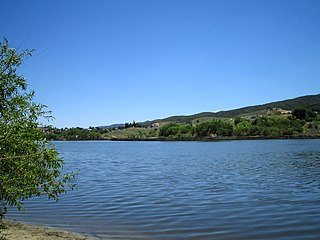
The Tejon Pass, previously known as Portezuelo de Cortes, Portezuela de Castac, and Fort Tejon Pass and also commonly referred to as “The Grapevine," is a mountain pass between the southwest end of the Tehachapi Mountains and northeastern San Emigdio Mountains, linking Southern California north to the Central Valley. It has been traversed by major roads such as the El Camino Viejo, the Stockton – Los Angeles Road, the Ridge Route, U.S. Route 99, and now Interstate 5.

Elizabeth Lake is a natural sag pond that lies directly on the San Andreas Fault in the northern Sierra Pelona Mountains, in northwestern Los Angeles County, southern California. The lake has been dry since 2013 because of prolonged drought.
El Camino Viejo a Los Ángeles, also known as El Camino Viejo and the Old Los Angeles Trail, was the oldest north-south trail in the interior of Spanish colonial Las Californias (1769–1822) and Mexican Alta California (1822–1848), present day California. It became a well established inland route, and an alternative to the coastal El Camino Real trail used since the 1770s in the period.
Poso de Chane or Poso Chane is a former settlement in Fresno County, California situated around the waterhole of that name, northwest just below the confluence of the Jacalitos Creek with Los Gatos Creek, 6 miles (9.7 km) east of Coalinga and northwest of the Guijarral Hills.
Alamo Solo Spring, a spring directly east of the Dagany Gap in the Pyramid Hills of Kern County, California. Its location appears on a 1914 USGS Topographic map of Lost Hills.
Little Panoche Creek formerly known as Arroyita de Panoche or Arroyo de Pannochita and later anglicized to Panochita Creek is a creek in Fresno County, California. The source of this creek is on the east slope of Glaucophane Ridge, of the Diablo Range in San Benito County. It flows east-northeast through Little Panoche Reservoir to empty into the California Aqueduct. Before the advent of irrigation projects in the valley, its waters might have reached a slough of the San Joaquin River in years of heavy rains.
Cantua Creek, formerly in Spanish Arroyo de Cantúa, was named for José de Guadalupe Cantúa, a prominent Californio Ranchero in the 19th-century Mexican era of Alta California.

Salt Spring, originally, Aguaje de la Brea, a spring in the Antelope Plain on the southeast end of Pyramid Hills, 0.6 miles south of Emigrant Hill and 1.5 miles north of Wagon Wheel Mountain in the Pyramid Hills of Kern County, California. Its location appears on a 1914 USGS Topographic map of Lost Hills. Salt Spring is located just east of the Pyramid Hills and the Devils Den Oil Field, 3 miles southwest of Devils Den, close by the south side of Kecks Road, 0.23 miles east of the California Aqueduct, enclosed by a fence.

San Emigdio Creek, formerly Arroyo de San Emigdio, is a 33 kilometres (21 mi) northward-flowing stream in western Kern County, central California.
Point of Rocks is a mountain range in Kern County, California.
Bitterwater Creek, originally named Arroyo de Matarano, is a stream in eastern San Luis Obispo County and northwestern Kern County, central California.
Carneros Creek, formerly Arroyo de Los Carneros is a stream with its source located on the east slope of the Temblor Range in San Luis Obispo County. It flows generally westward, until it emerges from the foothills of the Temblor Range, where it turns northwestward until it terminates at its confluence with Santos Creek, northwest of the Bacon Hills, in Kern County, California.
Aguaje de Las Berendas, or Antelope Springs, is a spring in located on the west side of the San Joaquin Valley, at the foot of the foothills of the Diablo Range, in Merced County, California.
Mud Spring, formerly called Aquaje Lodoso, is a spring and historic site in the western Antelope Valley, within northern Los Angeles County, southern California.
Alamo Mocho, was a watering place on the eastern route of the El Camino Viejo, seven miles northeast of Alamo Solo Spring within the Avenal Gap on the south end of the Kettleman Hills of Kern County, California.
Aguaje de Pedro Etchegoen was an aguaje, a little to the west of El Camino Viejo eight miles north of Poso de Chane where Pedro Etchegoen later established his sheep ranch. It was the only reliable watering place between the Poso and Cantua Creek. The Etchegoen or Etchegoin Ranch remained in the hands of his family up until the time of the Fresno oil boom. A Fresno Township map of 1907 shows it in the hands of William Etchegoen.
Aguaje Mesteño or Mustang Springs, is a watering place along El Camino Viejo, on Chico Martinez Creek, formerly Arroyo Chico Martinez. The springs are located in Kern County, California, United States.
Frank Forrest Latta (1892–1983), was a California historian and ethnographer of the Yokuts people. He also wrote histories of the early European-American settlement of the San Joaquin Valley.
La Vereda del Monte was a backcountry route through remote regions of the Diablo Range, one of the California Coast Ranges. La Vereda del Monte was the upper part of La Vereda Caballo,, used by mesteñeros from the early 1840s to drive Alta California horses to Sonora for sale.
Murrieta Rocks originally named Las Tinajas,, refers to the waterholes to be found eroded into the Vaqueros Sandstone on top of the outcrop. The location is at a large outcrop of Vaqueros Sandstone, called Murrieta Rocks, about a mile northeast of Brushy Peak just within the southern bounds of the Rancho Cañada de los Vaqueros in California. From the east, the outcrop overlooks a spring in an eastern tributary arroyo to the upper Kellogg Creek that flows down from Brushy Peak.




